SKODA OCTAVIA 2009 2.G / (1Z) Owner's Manual
Manufacturer: SKODA, Model Year: 2009, Model line: OCTAVIA, Model: SKODA OCTAVIA 2009 2.G / (1Z)Pages: 304, PDF Size: 19.56 MB
Page 121 of 304
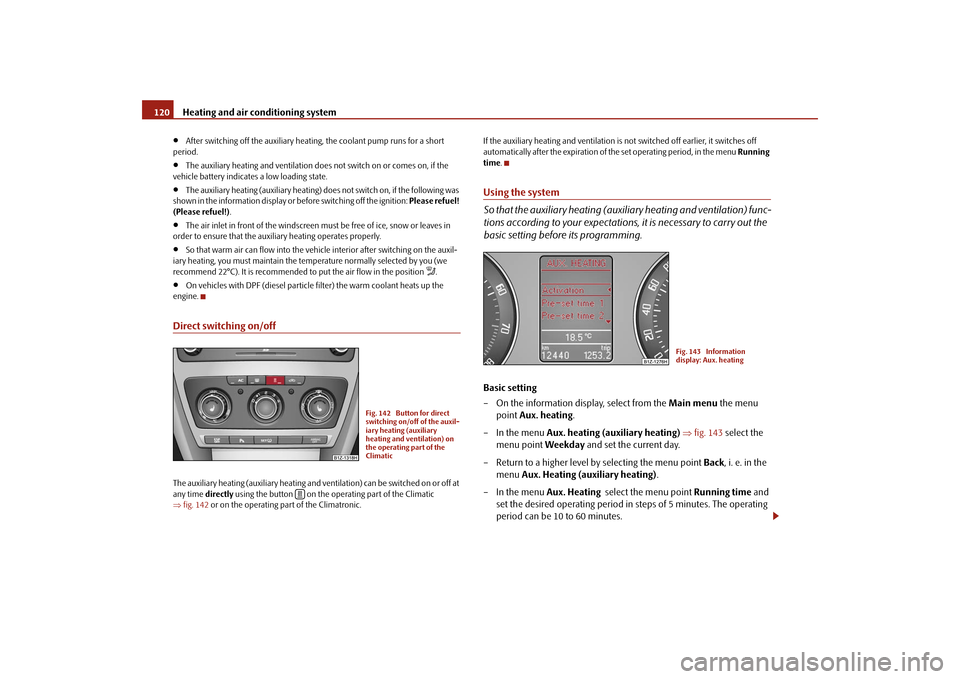
Heating and air conditioning system
120
•
After switching off the auxiliary heatin
g, the coolant pump runs for a short
period.•
The auxiliary heating and ventilation does not switch on or comes on, if the
vehicle battery indicates a low loading state.•
The auxiliary heating (auxiliary heating) does not switch on, if the following was
shown in the information display or before switching off the ignition:
Please refuel!
(Please refuel!)
.
•
The air inlet in front of the windscreen must be free of ice, snow or leaves in
order to ensure that the auxiliary heating operates properly.•
So that warm air can flow into the vehi
cle interior after switching on the auxil-
iary heating, you must maintain the te
mperature normally selected by you (we
recommend 22°C). It is recommended to
put the air flow in the position
.
•
On vehicles with DPF (diesel particle filter) the warm coolant heats up the
engine.Direct switching on/offThe auxiliary heating (auxiliary heating and ve
ntilation) can be switched on or off at
any time
directly
using the button on the operating part of the Climatic
⇒ fig. 142
or on the operating part of the Climatronic.
If the auxiliary heating and ventilation is not switched off earlier, it switches off automatically after the expiration of the set operating period, in the menu
Running
time
.
Using the system So that the auxiliary heating (auxiliary heating and ventilation) func- tions according to your expectations, it is necessary to carry out the basic setting before
its programming.
Basic setting – On the information display, select from the
Main menu
the menu
point
Aux. heating
.
– In the menu
Aux. heating (auxiliary heating)
⇒
fig. 143
select the
menu point
Weekday
and set the current day.
– Return to a higher level
by selecting the menu point
Back
, i. e. in the
menu
Aux. Heating (auxiliary heating)
.
– In the menu
Aux. Heating
select the menu point
Running time
and
set the desired operating period in steps of 5 minutes. The operating period can be 10 to 60 minutes.
Fig. 142 Button for direct switching on/off of the auxil-iary heating (auxiliary heating and ventilation) on the operating part of the Climatic
Fig. 143 Information display: Aux. heating
se0.1.book Page 120 Frida
y, April 10, 2009 3:19 PM
Page 122 of 304

Heating and air conditioning system
121
Using the system
Safety
Driving Tips
General Maintenance
Breakdown assistance
Technical Data
– By selecting the menu point
Back
, you will reach in the menu
Aux. Heating (auxiliary heating)
.
– In the menu
Aux. heating (auxiliary heating)
select the menu point
Mode
.
– In the menu
Mode
select the desired mode
Heating
or
Ventilation
.
ProgrammingFor the programming of the auxiliary heating (auxiliary heating and ventilation) in the menu
Aux. heating (Aux. heating)
there are three pre-set times:
•
Pre-set time 1
•
Pre-set time 2
•
Pre-set time 3
In each pre-set time, the day and the ti
me (hour and minute) can be set for
switching on the auxiliary heating and/or ventilation. An empty position can be found between
Sunday and Monday when selecting the
day. If this empty position
is selected, the activation is performed without taking
into account the day. If you leave the pre-set menu by selecting the menu
Back
or do not operate the
display for longer than 10°seconds, the set values are stored, but the pre-set time is not active. Both other pre-set times can be prog
rammed and stored in the same way.
If you select the menu
Activate
after setting the desired values, appears on the
display
Pre-set time (weekday, hours, minute) activated! (Pre-set time
(weekday, hour, minute) activated!
and the set pre-set time is active.
Only one programmed pre-set time can be active.The last programmed pre-set time remains active.After the auxiliary heating activates at the set time, it is necessary to pre-set a time again.
Changing the active pre-set time is carried out after selecting the menu point Activate
in the menu
Aux. heating (auxiliary heating)
by selecting a pre-set time.
The prerequisite for the correct switching on of the auxiliary heating (auxiliary heating and ventilation) according to th
e programmed pre-set time is the correct
setting of the current time and the weekday
⇒page 120.
If the system is running, a warning light in
the button for direct switching on/off of
the auxiliary heating lights up. The running system deactivates after expirati
on of the operating period or is deac-
tivated earlier by pres
sing the button for direct swit
ching on/off of the auxiliary
heating
⇒page 120.
The random pre-set time can be deactivated by selecting the menu point
Deactive
in the menu
Activate
.
After selecting the menu point
Fa c t o r y s e t t i n g
in the menu
Aux. heating
(auxiliary heating)
, it is possible to change to the factory setting.
se0.1.book Page 121 Frida
y, April 10, 2009 3:19 PM
Page 123 of 304

Starting-off and Driving
122
Starting-off and DrivingSetting steering wheel positionYou can set the height and the forward/back position of the steering wheel to the desired position. – Adjust the driver seat
⇒
page 12.
– Pull the lever below the steering column
⇒
fig. 144
down
⇒
.
– Set the steering wheel to the desired position (concerning height and
forward/back position).
– Push the lever upwards as far as the stop.
WARNING
•
You must not adjust the steering wh
eel when the vehicle is moving!
•
The driver must maintain a distance of at least 25 cm to the steering
wheel
⇒fig. 145
. Not maintaining this minimum distance will mean that the
airbag system will not be able to properly protect you - hazard!•
For s afe ty re a so ns t he le ve r m ust al wa y s b e fi rm ly pus he d up to a voi d the
steering wheel alteri
ng its position unintentionally when driving - risk of
accident!•
If you adjust the steering wheel furthe
r towards the head, you will reduce
the protection offered by the driver airb
ag in the event of an accident. Check
that the steering wheel is aligned to the chest.•
When driving, hold the steering wheel
with both hands firmly on the
outer edge in the 9 o'clock and 3 o'clock position. Never hold the steering wheel firmly in the 12 o'clock position or in another way (e.g. in the middle of the steering wheel or at the inner
steering wheel edge). In such cases,
injuries to the arms, the hands and
the head can occur when the driver
airbag is deployed.
Fig. 144 Adjustable steering wheel: Lever below steering columnFig. 145 Safe distance to steering wheel
se0.1.book Page 122 Frida
y, April 10, 2009 3:19 PM
Page 124 of 304

Starting-off and Driving
123
Using the system
Safety
Driving Tips
General Maintenance
Breakdown assistance
Technical Data
Ignition lockPetrol engines - ignition switched off, engine
off, the steering can be locked.
- ignition switched on - start engine Diesel engines - interruption of fuel supply, ignition sw
itched off, engine off, the steering can
be locked. - heating glow plugs on, ignition switched on•
You should not switch on any major elec
trical components during the heating
period otherwise the vehicle batter
y will be drained unnecessarily.
- start engine Applies to all models: Position
To lock the steering
, with the ignition key withdrawn, turn the steering wheel until
the steering locking pin is heard to engage.
You should always lock the steering as
a general rule if you leave your vehicle. This acts as a deterrent against possible theft of your vehicle
⇒
.
Position
Move the steering wheel back and forward a little if the ignition key cannot, or cannot easily be turned into
this position, in order to
release the steering lock.
Position
The engine is started in this position. At
the same time switched on low beam or
main beam or other electrical compon
ents with major po
wer consumption are
briefly switched off. The ignition key moves back into position when one releases the key. The ignition key must be turned back into
position each time before starting the
engine again. The starter repeat lock in th
e ignition lock prevents the starter being
engaged when the engine is running and thus getting damaged. Ignition key withdrawal lock (automatic gearbox) You can only withdraw the ignition key after switching off the ignition if the selector lever is in position
P.
WARNING
•
When driving, the ignition key must always be in the position (igni-
tion switched on) without the engine running. This position is indicated by the warning lights coming on. If this is not the case, it could result in unex- pected locking of the steering wheel - risk of accident!•
Only remove the ignition key from the ignition lock when the vehicle has
come to a standstill (by applying the handbrake or moving the selector lever into the position P). The steering lock
can engage immediately - risk of acci-
dent!•
Always withdraw the ignition key if
you are going to leave the vehicle,
even for a short time. This is particularly
important if children are left in the
vehicle. The children might otherwise star
t the engine or switch on electrical
equipment (e.g. power windows) - risk of accident or injury!
Fig. 146 Ignition lock posi- tions
A1A2A3A1A2A3
A1A2
A3
A2
A1
A2
se0.1.book Page 123 Frida
y, April 10, 2009 3:19 PM
Page 125 of 304
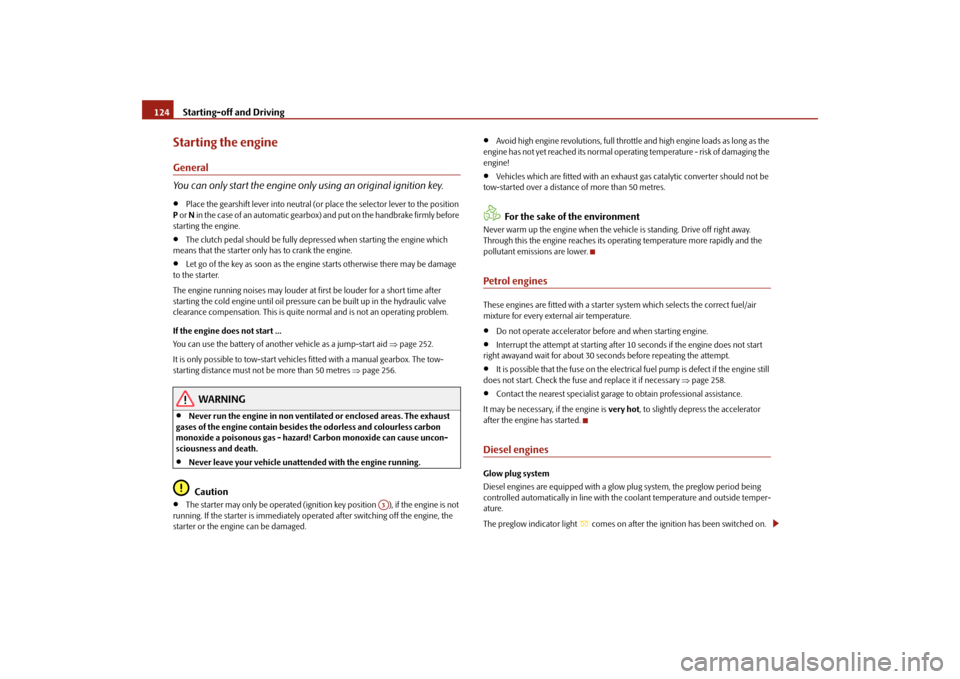
Starting-off and Driving
124
Starting the engineGeneral You can only start the engine only using an original ignition key.•
Place the gearshift lever into neutral (or place the selector lever to the position
P or N in the case of an automatic gearbox)
and put on the handbrake firmly before
starting the engine.•
The clutch pedal should be fully depressed when starting the engine which
means that the starter only has to crank the engine.•
Let go of the key as soon as the engine starts otherwise there may be damage
to the starter. The engine running noises ma
y louder at first be louder for a short time after
starting the cold engine until oil pressure
can be built up in the hydraulic valve
clearance compensation. This is quite no
rmal and is not an operating problem.
If the engine does not start ... You can use the battery of anothe
r vehicle as a jump-start aid
⇒page 252.
It is only possible to tow-start vehicles
fitted with a manual gearbox. The tow-
starting distance must not be more than 50 metres
⇒page 256.
WARNING
•
Never run the engine in non ventilat
ed or enclosed areas. The exhaust
gases of the engine contain besides the odorless and colourless carbon monoxide a poisonous gas - hazard!
Carbon monoxide can cause uncon-
sciousness and death.•
Never leave your vehicle unattended with the engine running.Caution
•
The starter may only be operated (ignition key position ), if the engine is not
running. If the starter is i
mmediately operated
after switching off the engine, the
starter or the engine can be damaged.
•
Avoid high engine revolutions, full throttle and high engine loads as long as the
engine has not yet reached its normal oper
ating temperature - risk of damaging the
engine!•
Vehicles which are fitted with an exhaus
t gas catalytic conver
ter should not be
tow-started over a distance of more than 50 metres.
For the sake of the environment
Never warm up the engine when the vehi
cle is standing. Drive off right away.
Through this the engine reaches its operating temperature more rapidly and the pollutant emissions are lower.Petrol enginesThese engines are fitted with a starter system which selects the correct fuel/air mixture for every external air temperature.•
Do not operate accelerator befo
re and when starting engine.
•
Interrupt the attempt at starting after 10 seconds if the engine does not start
right awayand wait for about 30 seconds before repeating the attempt.•
It is possible that the fuse on the electrical fuel pump is defect if the engine still
does not start. Check the fuse and replace it if necessary
⇒page 258.
•
Contact the nearest specialist garage to obtain professional assistance.
It may be necessary, if the engine is
very hot
, to slightly depress the accelerator
after the engine has started.Diesel enginesGlow plug system Diesel engines are equipped with a glow plug system, the preglow period being controlled automatically in line with the coolant temperature and outside temper-ature. The preglow indicator light
comes on after the igniti
on has been switched on.
A3
se0.1.book Page 124 Frida
y, April 10, 2009 3:19 PM
Page 126 of 304
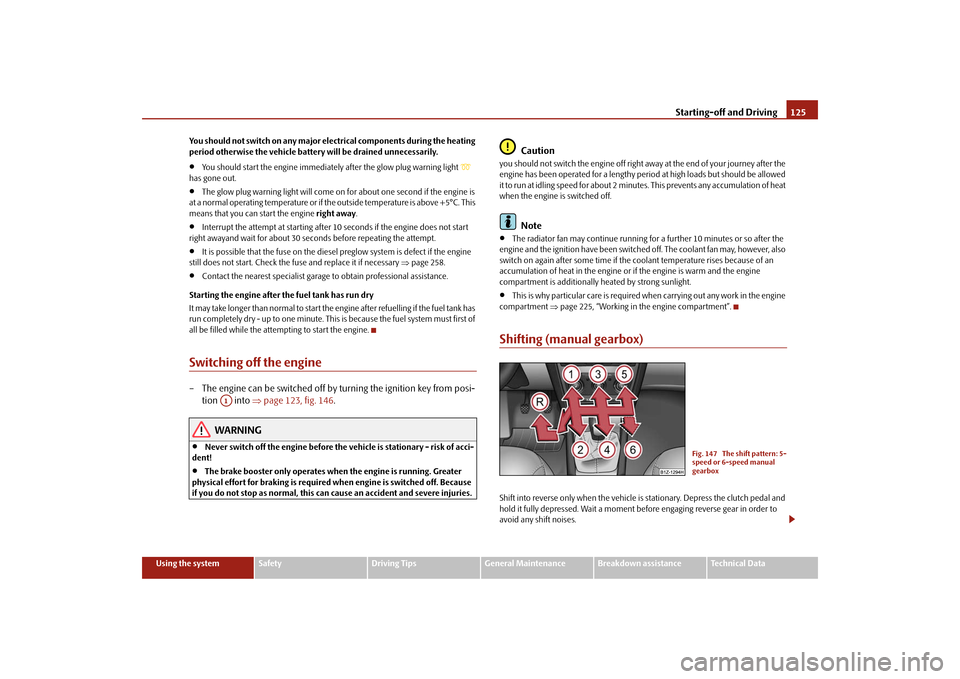
Starting-off and Driving
125
Using the system
Safety
Driving Tips
General Maintenance
Breakdown assistance
Technical Data
You should not switch on any major electrical components during the heating period otherwise the vehicle battery will be drained unnecessarily.•
You should start the engine immediately after the glow plug warning light
has gone out.•
The glow plug warning light will come on for about one second if the engine is
at a normal operating temperature or if th
e outside temperature is above +5°C. This
means that you can start the engine
right away
.
•
Interrupt the attempt at starting after 10 seconds if the engine does not start
right awayand wait for about 30 seconds before repeating the attempt.•
It is possible that the fuse on the diesel
preglow system is defect if the engine
still does not start. Check the fuse and replace it if necessary
⇒page 258.
•
Contact the nearest specialist garage to obtain professional assistance.
Starting the engine after the fuel tank has run dry It may take longer than normal to start the
engine after refuelling if the fuel tank has
run completely dry - up to one minute. This is because the fuel system must first of all be filled while the attempting to start the engine.Switching off the engine– The engine can be switched off by turning the ignition key from posi-
tion into
⇒
page 123, fig. 146
.
WARNING
•
Never switch off the engine before the
vehicle is stationary - risk of acci-
dent!•
The brake booster only operates when the engine is running. Greater
physical effort for braking is required
when engine is switched off. Because
if you do not stop as normal, this can cause an accident and severe injuries.
Caution
you should not switch the engine off right
away at the end of yo
ur journey
after the
engine has been operated for a lengthy peri
od at high loads but should be allowed
it to run at idling speed for about 2 minutes
. This prevents any accumulation of heat
when the engine is switched off.
Note
•
The radiator fan may conti
nue running for a further 10
minutes or
so after the
engine and the ignition have
been switched off. The coolant fan may, however, also
switch on again after some time if the
coolant temperature rises because of an
accumulation of heat in the engine or
if the engine is warm and the engine
compartment is additionally
heated by strong sunlight.
•
This is why particular care is required when carrying out any work in the engine
compartment
⇒page 225, “Working in the engine compartment”.
Shifting (manual gearbox)Shift into reverse only when the vehicle is
stationary. Depress the clutch pedal and
hold it fully depressed. Wait a moment be
fore engaging reverse gear in order to
avoid any shift noises.
A1
Fig. 147 The shift pattern: 5- speed or 6-speed manual gearbox
se0.1.book Page 125 Frida
y, April 10, 2009 3:19 PM
Page 127 of 304

Starting-off and Driving
126
The reversing lights will come on once reverse gear is engaged, provided the igni- tion is on.
WARNING
Never engage the reverse gear when driving - risk of accident!
Note
•
One should not lay the hand on the shift lever while driving the vehicle. The
pressure of the hand will be transferred to
the gearshift forks in the gearbox. This
can, over a period of time, lead to early wear of the gearshift forks.•
Depress the clutch pedal fully when chan
ging gears, in order to avoid unneces-
sary wear and damage to the clutch.HandbrakeApplying the handbrake – Pull the handbrake lever up fully.
Releasing the handbrake – Pull the handbrake lever up slightly
and
at the same time
press in the
locking button
⇒
fig. 148
.
– Hold the button pressed and push the handbrake lever down fully
⇒
.
The handbrake warning light
lights up when the handbrake is applied, provided
the ignition is on. A warning signal sounds and the following text appears in the display* if you have inadvertently driven off with the handbrake applied:
Handbrake on
The handbrake warning is activated if you drive at a speed of more than 6 km/h for more than 3 seconds.
WARNING
•
Please note that the handbrake must be fully released. A handbrake
which is only partially released can re
sult in the rear brakes overheating
which will have a negative effect on the operation of the brake system - risk of accident! In addition this can result in premature wear of the rear brake pads.•
Never leave children unattended in the vehicle. The children might, for
example, release the handbrake or take the vehicle out of gear. The vehicle might then move off - risk of accident!
Caution
After the car has come to a stop, always firs
t of all apply the handbrake firmly before
then additionally engaging a gear (manual gearbox) or moving the selector lever into position
P (automatic gearbox).
Fig. 148 Centre console: Handbrake
se0.1.book Page 126 Frida
y, April 10, 2009 3:19 PM
Page 128 of 304
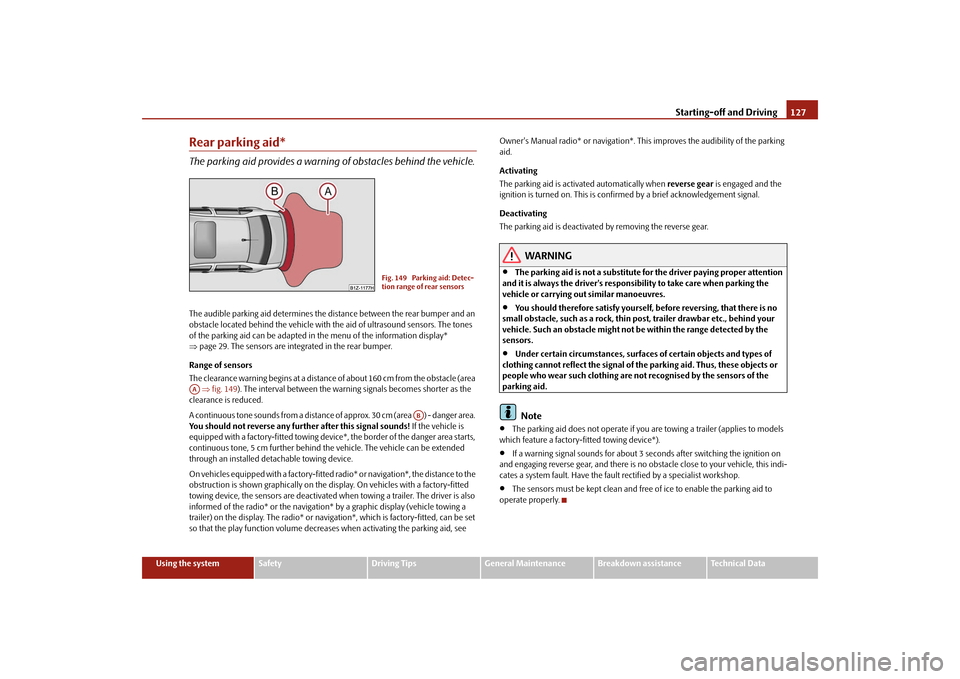
Starting-off and Driving
127
Using the system
Safety
Driving Tips
General Maintenance
Breakdown assistance
Technical Data
Rear parking aid*The parking aid provides a warning of obstacles behind the vehicle.The audible parking aid determines the distance between the rear bumper and an obstacle located behind the vehicle with
the aid of ultrasound sensors. The tones
of the parking aid can be adapted in
the menu of the information display*
⇒ page 29. The sensors are integrated in the rear bumper. Range of sensors The clearance warning begins at a distance
of about 160 cm from the obstacle (area
⇒fig. 149
). The interval between the warning signals becomes shorter as the
clearance is reduced. A continuous tone sounds from a distance
of approx. 30 cm (area ) - danger area.
You should not reverse any further after this signal sounds!
If the vehicle is
equipped with a factory-fitted towing device*, the border of the danger area starts, continuous tone, 5 cm further behind th
e vehicle. The vehicle can be extended
through an installed detachable towing device. On vehicles equipped with a factory-fitted
radio* or navigation*, the distance to the
obstruction is shown graphically on the disp
lay. On vehicles with a factory-fitted
towing device, the sensors are deactivated when towing a trailer. The driver is also informed of the radio* or the navigation
* by a graphic display (vehicle towing a
trailer) on the display. The radio* or navi
gation*, which is factory-fitted, can be set
so that the play function volume decrea
ses when activating the parking aid, see
Owner's Manual radio* or navigation*. This
improves the audibility of the parking
aid. Activating The parking aid is activated automatically when
reverse gear
is engaged and the
ignition is turned on. This is conf
irmed by a brief acknowledgement signal.
Deactivating The parking aid is deactivated by removing the reverse gear.
WARNING
•
The parking aid is not a substitute for the driver paying proper attention
and it is always the driver's responsibility to take care when parking the vehicle or carrying ou
t similar manoeuvres.
•
You should therefore satisfy yourself, before reversing, that there is no
small obstacle, such as a rock, thin post, trailer drawbar etc., behind your vehicle. Such an obstacle might not
be within the range detected by the
sensors.•
Under certain circumstances, surfaces of certain objects and types of
clothing cannot reflect the signal of th
e parking aid. Thus, these objects or
people who wear such clothing are not recognised by the sensors of the parking aid.
Note
•
The parking aid does not operate if you are towing a trailer (applies to models
which feature a factory-fi
tted towing device*).
•
If a warning signal sounds for about 3 seconds after switching the ignition on
and engaging reverse gear, and there is no ob
stacle close to your vehicle, this indi-
cates a system fault. Have the fault rectified by a specialist workshop.•
The sensors must be kept clean and free of ice to enable the parking aid to
operate properly.
Fig. 149 Parking aid: Detec- tion range of rear sensors
AA
AB
se0.1.book Page 127 Frida
y, April 10, 2009 3:19 PM
Page 129 of 304
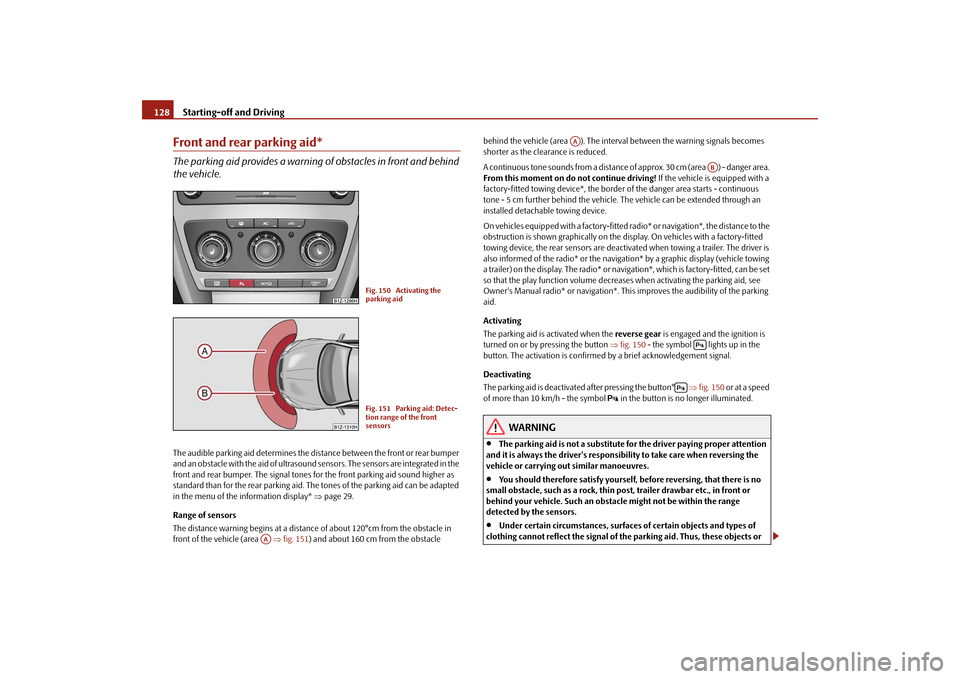
Starting-off and Driving
128
Front and rear parking aid*The parking aid provides a warning of obstacles in front and behind the vehicle.The audible parking aid determines the distance between the front or rear bumper and an obstacle with the aid of ultrasound sensors. The sensors are integrated in the front and rear bumper. The signal tones for the front parking aid sound higher as standard than for the rear parking aid. The tones of the parking aid can be adapted in the menu of the information display*
⇒page 29.
Range of sensors The distance warning begins at a distance
of about 120°cm from the obstacle in
front of the vehicle (area
⇒fig. 151
) and about 160 cm from the obstacle
behind the vehicle (area ). The interv
al between the warning signals becomes
shorter as the clearance is reduced. A continuous tone sounds from a distance
of approx. 30 cm (area ) - danger area.
From this moment on do not continue driving!
If the vehicle is equipped with a
factory-fitted towing device*, the border
of the danger area
starts - continuous
tone - 5 cm further behind
the vehicle. The vehicle ca
n be extended through an
installed detachable towing device. On vehicles equipped with a factory-fitted radio* or navigation*, the distance to the obstruction is shown graphically on the di
splay. On vehicles with a factory-fitted
towing device, the rear sensors are deactivated when towing a trailer. The driver is also informed of the radio* or the navigation* by a graphic display (vehicle towing a trailer) on the display. The radio* or navi
gation*, which is factory-fitted, can be set
so that the play function volume decreases when activating the parking aid, see Owner's Manual radio* or navigation*. This
improves the audibili
ty of the parking
aid. Activating The parking aid is activated when the
reverse gear
is engaged and the ignition is
turned on or by pressing the button
⇒fig. 150
- the symbol lights up in the
button. The activation is confirmed
by a brief acknowledgement signal.
Deactivating The parking aid is deactivate
d after pressing the button°
⇒fig. 150
or at a speed
of more than 10 km/h - the symbol
in the button is no longer illuminated.
WARNING
•
The parking aid is not a substitute fo
r the driver paying proper attention
and it is always the driver's responsibility to take care when reversing the vehicle or carrying out similar manoeuvres.•
You should therefore satisfy yourself, before reversing, that there is no
small obstacle, such as a rock, thin post, trailer drawbar etc., in front or behind your vehicle. Such an obstacle might not be within the range detected by the sensors.•
Under certain circumstances, surfaces of certain objects and types of
clothing cannot reflect the signal of the parking aid. Thus, these objects or
Fig. 150 Activating the parking aidFig. 151 Parking aid: Detec-tion range of the front sensors
AA
AA
AB
se0.1.book Page 128 Frida
y, April 10, 2009 3:19 PM
Page 130 of 304
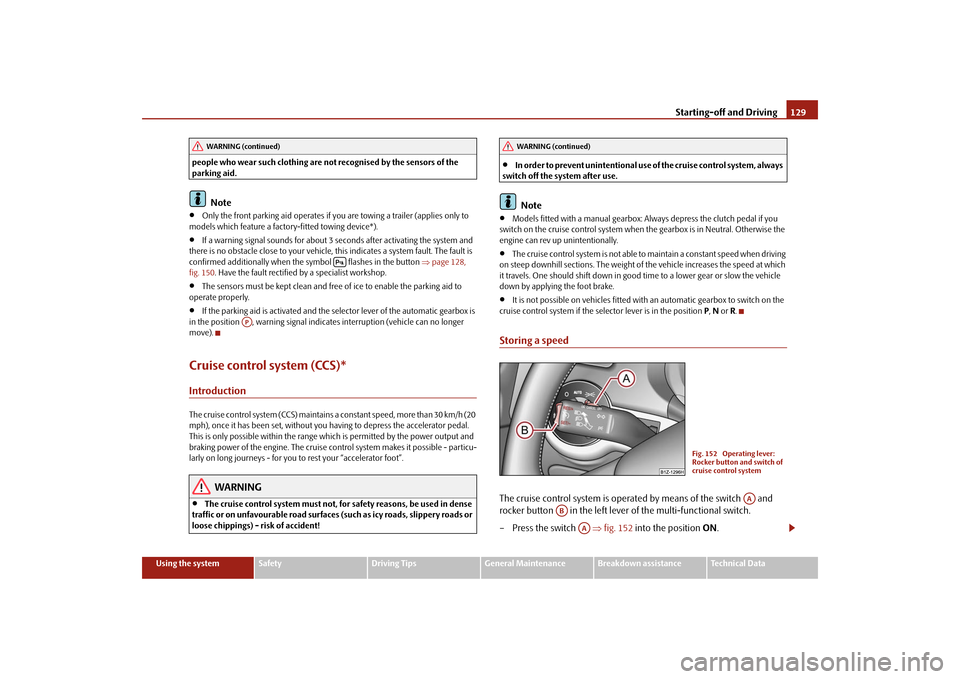
Starting-off and Driving
129
Using the system
Safety
Driving Tips
General Maintenance
Breakdown assistance
Technical Data
people who wear such clothing are not recognised by the sensors of the parking aid.
Note
•
Only the front parking aid operates if you are towing a trailer (applies only to
models which feature a factory-fitted towing device*).•
If a warning signal sounds for about 3 seconds after activating the system and
there is no obstacle close to your vehicle,
this indicates a system fault. The fault is
confirmed additionally
when the symbol flashes in the button
⇒page 128,
fig. 150
. Have the fault rectified by a specialist workshop.
•
The sensors must be kept clean and free of ice to enable the parking aid to
operate properly.•
If the parking aid is activated and the se
lector lever of the automatic gearbox is
in the position , warning signal indicates interruption (vehicle can no longer move).Cruise control system (CCS)*IntroductionThe cruise control system (CCS) maintains a constant speed, more than 30 km/h (20 mph), once it has been set, without you
having to depress the accelerator pedal.
This is only possible within the range wh
ich is permitted by the power output and
braking power of the engine. The cruise co
ntrol system makes it possible - particu-
larly on long journeys - for you
to rest your “accelerator foot”.
WARNING
•
The cruise control system must not, for safety reasons, be used in dense
traffic or on unfavourable road surfaces (such as icy roads, slippery roads or loose chippings) - risk of accident!
•
In order to prevent unintentional use of the cruise control system, always
switch off the system after use.
Note
•
Models fitted with a manual gearbox: Al
ways depress the clutch pedal if you
switch on the cruise control system when
the gearbox is in Neutral. Otherwise the
engine can rev up unintentionally.•
The cruise control system is not able to maintain a constant speed when driving
on steep downhill sections. The weight of
the vehicle increases the speed at which
it travels. One should shift down in good
time to a lower gear or slow the vehicle
down by applying the foot brake.•
It is not possible on vehicles fitted with
an automatic gearbo
x to switch on the
cruise control system if the sele
ctor lever is in the position
P, N or R.
Storing a speedThe cruise control system is operat
ed by means of the switch and
rocker button in the left lever of the multi-functional switch. – Press the switch
⇒
fig. 152
into the position
ON
.
WARNING (continued)
AP
WARNING (continued)
Fig. 152 Operating lever: Rocker button and switch of cruise control system
AA
AB
AA
se0.1.book Page 129 Frida
y, April 10, 2009 3:19 PM